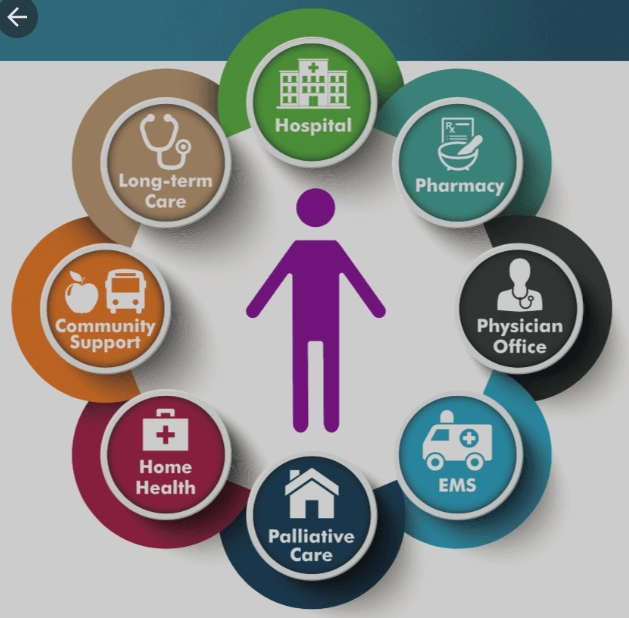

How to build a care coordination model for hospital or clinic
Good care coordination can save lives, reach vulnerable people, and proactively help to improve the well-being of people in your community - or across your health system. Inefficient care coordination is visible when a patient goes to the hospital. When no one can find their patients’ history; when it takes too long to confirm their insurance; when doctors or nurses don’t come in the ward when patients need help.
So, what is care coordination for hospitals? Care coordination includes activities aimed at creating the most comfortable conditions for a patient and effective provision of healthcare services. It creates more chances for a patient to get qualitative care with less time and at a reduced cost. In other words, a patient, healthcare provider, and care team collaborate to meet the patient’s needs - and patients achieve their healthcare goals faster and with the least effort.
But here, another question arises. How to arrange efficient coordination?
Ensure continuity of services
When choosing a particular care coordination model and thinking of ways to implement it, you should always keep in mind that your chosen model should be a patient-centered one. All participants of any care coordination model work in the same direction ‒ to provide efficient delivery of care. Plus, it’s better to always think of what is called “continuity of services”. Simply put, all providers within the model should interact to achieve the common goal.
Moreover, we shouldn’t forget that coordinated care is not just about medical services. It is also intended for satisfying non-medical needs, like food, housing, etc. Only this way, a coordination model will be a working one.
Thus, how to achieve continuity of services? In the practice brief on the continuity and coordination of care, the World Health Organization provides four approaches to exercise continuity of services effectively.
The interpersonal continuity approach provides that all care coordination model participants (patients, caregivers, providers) trust each other and all care needs are satisfied by one central care provider. Coordinated care is flexible, consistent, and adapted to patients’ beliefs. A continuing therapeutic relationship is established.
According to the longitudinal continuity approach, care and follow-up services are provided by a professional or team at all levels. Also, it includes discharge planning from admission and referral strategies for care professionals. Social networks support the provision of services.
The management continuity calls for case management across sectors and shared collaborative care by an interdisciplinary team. Also, it includes detection of high-risk patients and regular monitoring of long-term conditions. Care planning is carried out considering the recommendations of multiple providers.
The informal continuity approach is primarily about positive patient-provider communication. It includes shared and synchronized care records and standardized clinical protocols in all care settings. Information is shared among providers to ensure “collective memory”.

Consider digital healthcare development services
All aspects described above are essential components of integrated care coordination services. However, in the era of digitalization, efficient care coordination is impossible without appropriate coordination tools. Computer programs are used in all spheres of human activities, and healthcare is not an exception.
The market is flooded with healthcare solutions and development services. Programming companies offer healthcare web platforms, programs, and mobile apps to optimize doctor-patient interaction. What is more, they deliver flawless integration with third-party services to build smooth workflows. These companies leverage technological innovations streamlining communication between patients and caregivers.
Digital care coordination tools ensure systematic interaction between all patients, providers, and caregivers. This way, all participants can access the necessary info whenever they need it. Care coordination tools usually include electronic health records, apps to schedule appointments, chats, online payment tools, real-time hospital workflow analytics, etc.
Consequently, software tools are as important as any other aspect of the care coordination system. They allow providers to work across all healthcare settings. Software developers in healthcare startups contribute greatly to the healthcare system as a whole, and, at this time, they are absolutely necessary. The computer experts successfully combine knowledge of healthcare system complexity and software engineering skills to deliver effective solutions.
Extend your care outreach beyond your hospital or clinic
To increase accessibility and availability of care, you can collaborate with care coordination programs that are established in communities of your patients. There are different types of such programs, and some of them are listed below.
1. Program of All-Inclusive Care for the Elderly (PACE)
PACE is a care coordination program for people older than 55 years of age. Participants of the program get qualitative, coordinated care remaining in the community. What is more, the program’s financing allows patients to get all services they need - not only reimbursable ones.
2. Wraparound Programs
Wraparound Programs are for children with behavioral health issues and conditions alike and their families. It’s a good idea to connect with programs like that one - especially if they operate in the rural areas where children often cannot get qualified and affordable help from psychiatrists.
3. Community HUB Program
This program is aimed to help vulnerable and at-risk populations. Its main task is to increase access to integrated healthcare and make it more accessible.
4. Community Health Workers Program (CHWs)
CHWs are a team of specialists that help and coordinate people with complex health conditions. These may be paid workers or volunteers that share with the community members ethnicity, language, culture, socioeconomic status, values, and life experiences.
5. Nurse-Family Partnership Program (NFP)
NFP is a program developed for first-time mothers with low incomes. Nurses provide support to young mothers from pregnancy till the child is two years of age. This way, young mothers and their babies get assistance, recommendations, and resources.
Health Homes are developed to provide professional care to people with chronic illnesses. People get primary and acute care and behavioral health services.
7. Mobile Unit Program
Mobile Unit was developed with hard-to-reach individuals in mind. This approach involves vans or tracks to provide services to people who don’t have access to transportation services or can’t leave their current place.
8. Supportive Housing Program
Supportive Housing Program is a combination of housing, healthcare, and human services provided to people in difficult situations: for instance, for homeless people.
Conclusion - coordination model for hospital and clinic
Building care coordination tool requires to cover lots of things: development (or choosing) of easy-to-use EHR, integrating it with tools for a smooth workflow (like remote monitoring tools or routing apps for nurses), making sure emergency department processes are tightly connected to the primary care systems, and so on. Removing redundancies in administrative work and workforce tech and security training are essential components to that process as well. But, if you adopt these, you’ll get a) incredible efficiency and care quality that rises up along with doctors and nurses’ job satisfaction, b) customer service that will make your patients less anxious, more confident, and even happy.
If you want to know more about software that makes healthcare organizations’ workflows quicker and allows them to deliver better care, subscribe to our newsletter below.
Tell us about your project
Fill out the form or contact us

Tell us about your project
Thank you
Your submission is received and we will contact you soon
Follow us
